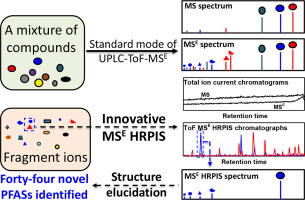当前位置:
X-MOL 学术
›
Anal. Chim. Acta
›
论文详情
Our official English website, www.x-mol.net, welcomes your
feedback! (Note: you will need to create a separate account there.)
Identification of novel non-ionic, cationic, zwitterionic, and anionic polyfluoroalkyl substances using UPLC–TOF–MS E high-resolution parent ion search
Analytica Chimica Acta ( IF 5.7 ) Pub Date : 2017-10-01 , DOI: 10.1016/j.aca.2017.08.016 Feng Xiao , Svetlana A. Golovko , Mikhail Y. Golovko
Analytica Chimica Acta ( IF 5.7 ) Pub Date : 2017-10-01 , DOI: 10.1016/j.aca.2017.08.016 Feng Xiao , Svetlana A. Golovko , Mikhail Y. Golovko

|
Poly- and perfluoroalkyl substances (poly- and per-PFASs) are a large group of organic compounds that have become the target of investigation due to their widespread occurrence in the environment and biota, coupled with their known or suspected impacts on human health. Recent studies have shown that a significant portion of poly-PFASs remain unidentified. This study presents a time-of-flight mass spectrometry approach based on continuously interleaving scans at low and high collision energies (ToF-MSE) for the rapid identification and characterization of unknown PFASs. The MSE mode allowed for the simultaneous acquisition of full-spectrum accurate mass data of both parent and fragment ions in a single chromatographic run. Specific to PFASs, the hypothesis that PFASs can be selectively detected by the ToF-MSE high-resolution parent-ion search (HRPIS) of their characteristic fragments was confirmed with certified standards of 24 poly- and per-PFAS. After being validated with these certified standards, the innovative HRPIS approach was applied to a group of commercial surfactants, which led to the identification of 47 new and 43 infrequently reported PFASs, including 40 non-ionic, 30 cationic, 15 zwitterionic, and five anionic compounds. It is envisaged that the results, especially the identification of new non-ionic PFASs, may provide important insights into the historical occupational and non-occupational exposure to PFASs from the production and application of these surfactants.
中文翻译:

使用 UPLC-TOF-MS E 高分辨率母离子搜索鉴定新型非离子、阳离子、两性离子和阴离子多氟烷基物质
聚和全氟烷基物质(聚和全氟烷基物质)是一大类有机化合物,由于它们在环境和生物群中广泛存在,加上它们对人类健康的已知或可疑影响,已成为研究的目标。最近的研究表明,很大一部分聚全氟和多氟烷基物质仍未被识别。本研究提出了一种基于低和高碰撞能量 (ToF-MSE) 连续交错扫描的飞行时间质谱方法,用于快速识别和表征未知的 PFAS。MSE 模式允许在单次色谱运行中同时采集母离子和碎片离子的全谱准确质量数据。特定于 PFAS,PFAS 可以通过其特征片段的 ToF-MSE 高分辨率母离子搜索 (HRPIS) 选择性检测的假设得到了 24 种聚和全 PFAS 的认证标准的证实。在使用这些认证标准进行验证后,将创新的 HPIS 方法应用于一组商业表面活性剂,从而鉴定出 47 种新的和 43 种不常报告的全氟和多氟烷基物质,包括 40 种非离子型、30 种阳离子型、15 种两性离子型和 5 种阴离子型化合物。预计这些结果,尤其是新的非离子 PFAS 的鉴定,可能为了解这些表面活性剂的生产和应用中 PFAS 的历史职业和非职业暴露提供重要见解。在使用这些认证标准进行验证后,将创新的 HPIS 方法应用于一组商业表面活性剂,从而鉴定出 47 种新的和 43 种不常报告的全氟和多氟烷基物质,包括 40 种非离子型、30 种阳离子型、15 种两性离子型和 5 种阴离子型化合物。预计这些结果,尤其是新的非离子 PFAS 的鉴定,可能为了解这些表面活性剂的生产和应用中 PFAS 的历史职业和非职业暴露提供重要见解。在使用这些认证标准进行验证后,将创新的 HPIS 方法应用于一组商业表面活性剂,从而鉴定出 47 种新的和 43 种不常报告的全氟和多氟烷基物质,包括 40 种非离子型、30 种阳离子型、15 种两性离子型和 5 种阴离子型化合物。预计这些结果,尤其是新的非离子 PFAS 的鉴定,可能为了解这些表面活性剂的生产和应用中 PFAS 的历史职业和非职业暴露提供重要见解。
更新日期:2017-10-01
中文翻译:

使用 UPLC-TOF-MS E 高分辨率母离子搜索鉴定新型非离子、阳离子、两性离子和阴离子多氟烷基物质
聚和全氟烷基物质(聚和全氟烷基物质)是一大类有机化合物,由于它们在环境和生物群中广泛存在,加上它们对人类健康的已知或可疑影响,已成为研究的目标。最近的研究表明,很大一部分聚全氟和多氟烷基物质仍未被识别。本研究提出了一种基于低和高碰撞能量 (ToF-MSE) 连续交错扫描的飞行时间质谱方法,用于快速识别和表征未知的 PFAS。MSE 模式允许在单次色谱运行中同时采集母离子和碎片离子的全谱准确质量数据。特定于 PFAS,PFAS 可以通过其特征片段的 ToF-MSE 高分辨率母离子搜索 (HRPIS) 选择性检测的假设得到了 24 种聚和全 PFAS 的认证标准的证实。在使用这些认证标准进行验证后,将创新的 HPIS 方法应用于一组商业表面活性剂,从而鉴定出 47 种新的和 43 种不常报告的全氟和多氟烷基物质,包括 40 种非离子型、30 种阳离子型、15 种两性离子型和 5 种阴离子型化合物。预计这些结果,尤其是新的非离子 PFAS 的鉴定,可能为了解这些表面活性剂的生产和应用中 PFAS 的历史职业和非职业暴露提供重要见解。在使用这些认证标准进行验证后,将创新的 HPIS 方法应用于一组商业表面活性剂,从而鉴定出 47 种新的和 43 种不常报告的全氟和多氟烷基物质,包括 40 种非离子型、30 种阳离子型、15 种两性离子型和 5 种阴离子型化合物。预计这些结果,尤其是新的非离子 PFAS 的鉴定,可能为了解这些表面活性剂的生产和应用中 PFAS 的历史职业和非职业暴露提供重要见解。在使用这些认证标准进行验证后,将创新的 HPIS 方法应用于一组商业表面活性剂,从而鉴定出 47 种新的和 43 种不常报告的全氟和多氟烷基物质,包括 40 种非离子型、30 种阳离子型、15 种两性离子型和 5 种阴离子型化合物。预计这些结果,尤其是新的非离子 PFAS 的鉴定,可能为了解这些表面活性剂的生产和应用中 PFAS 的历史职业和非职业暴露提供重要见解。











































 京公网安备 11010802027423号
京公网安备 11010802027423号